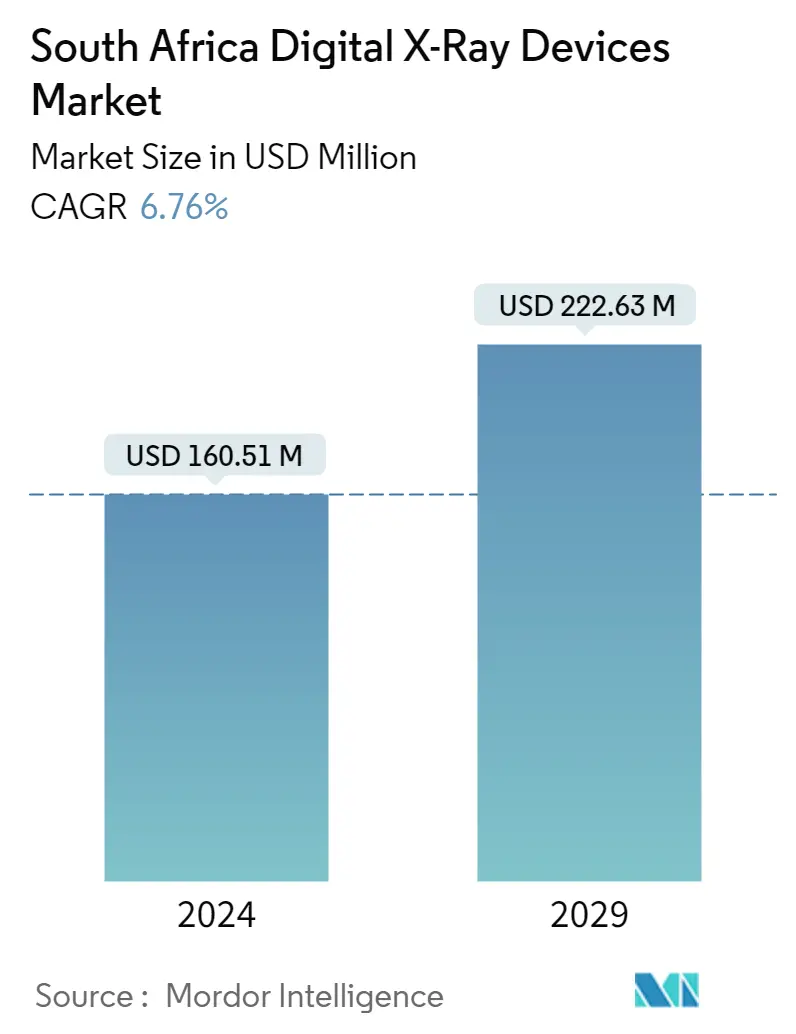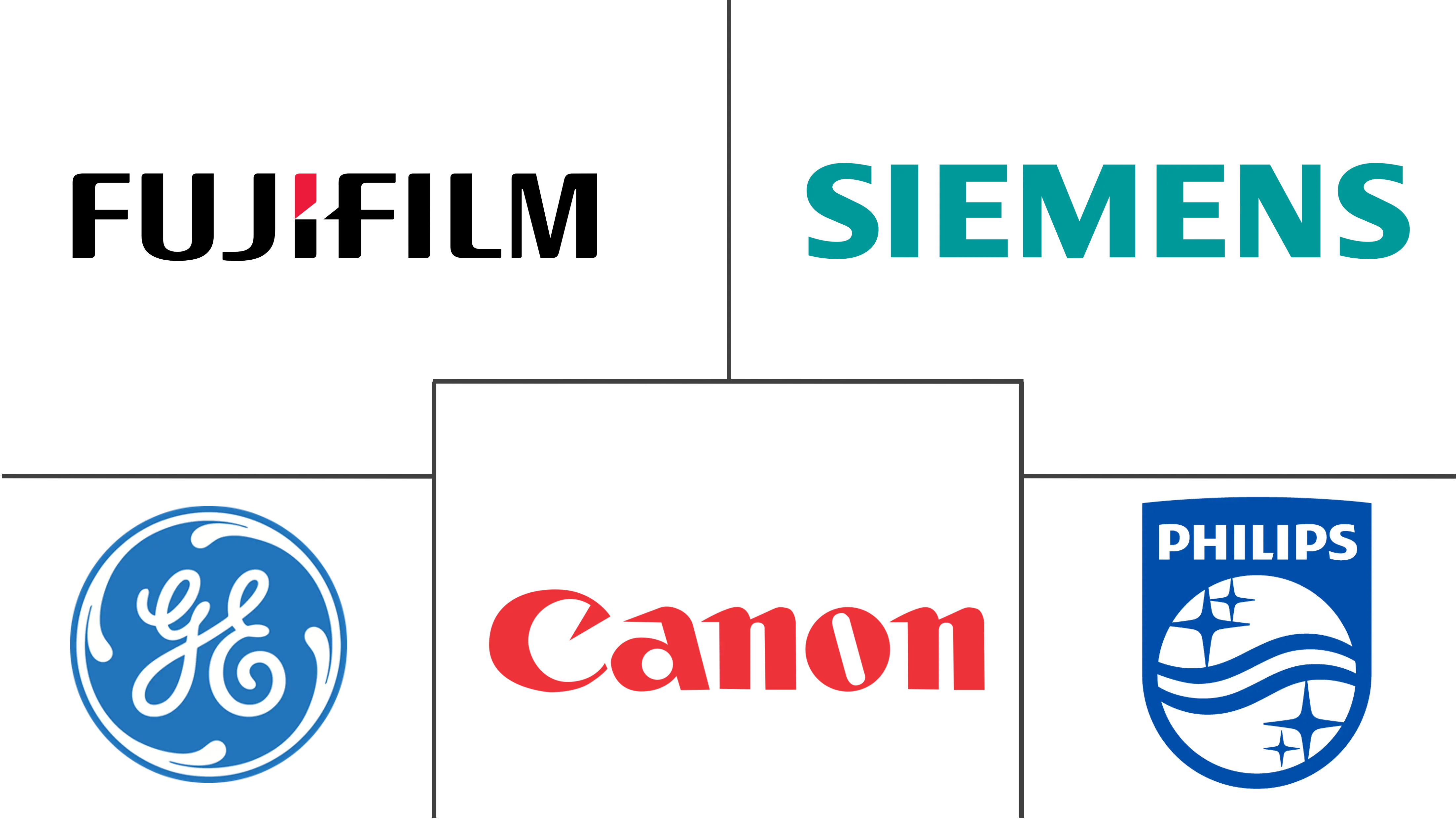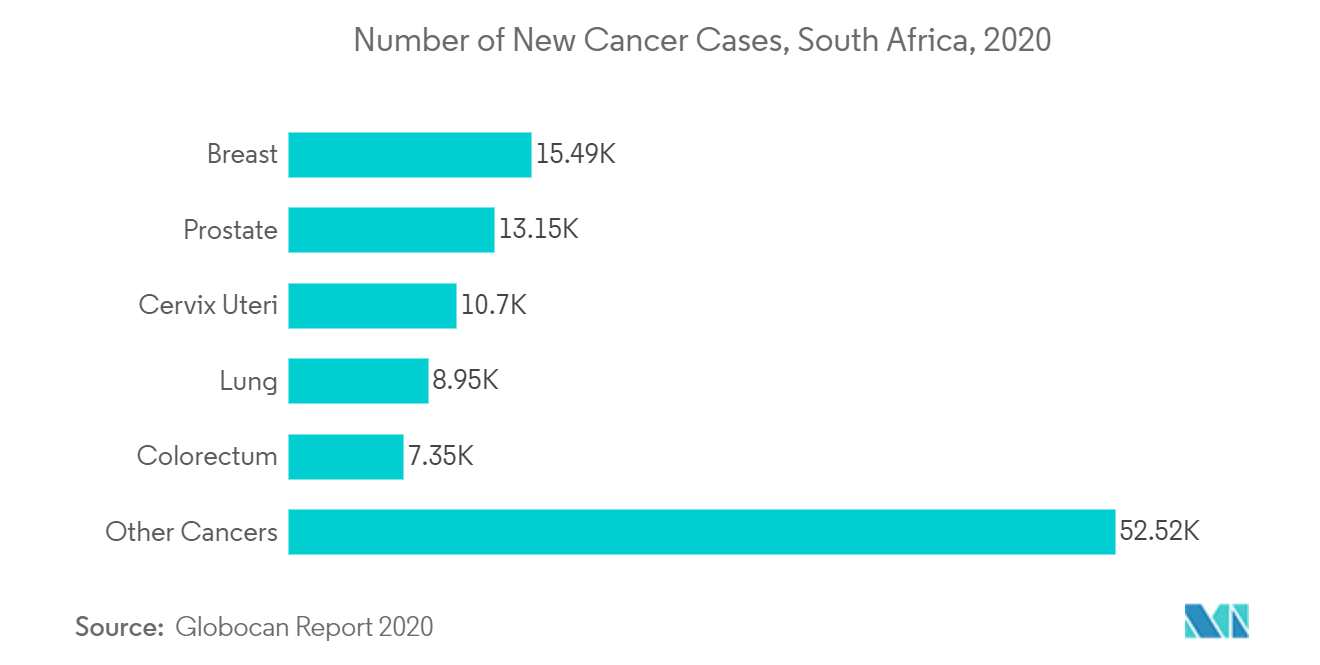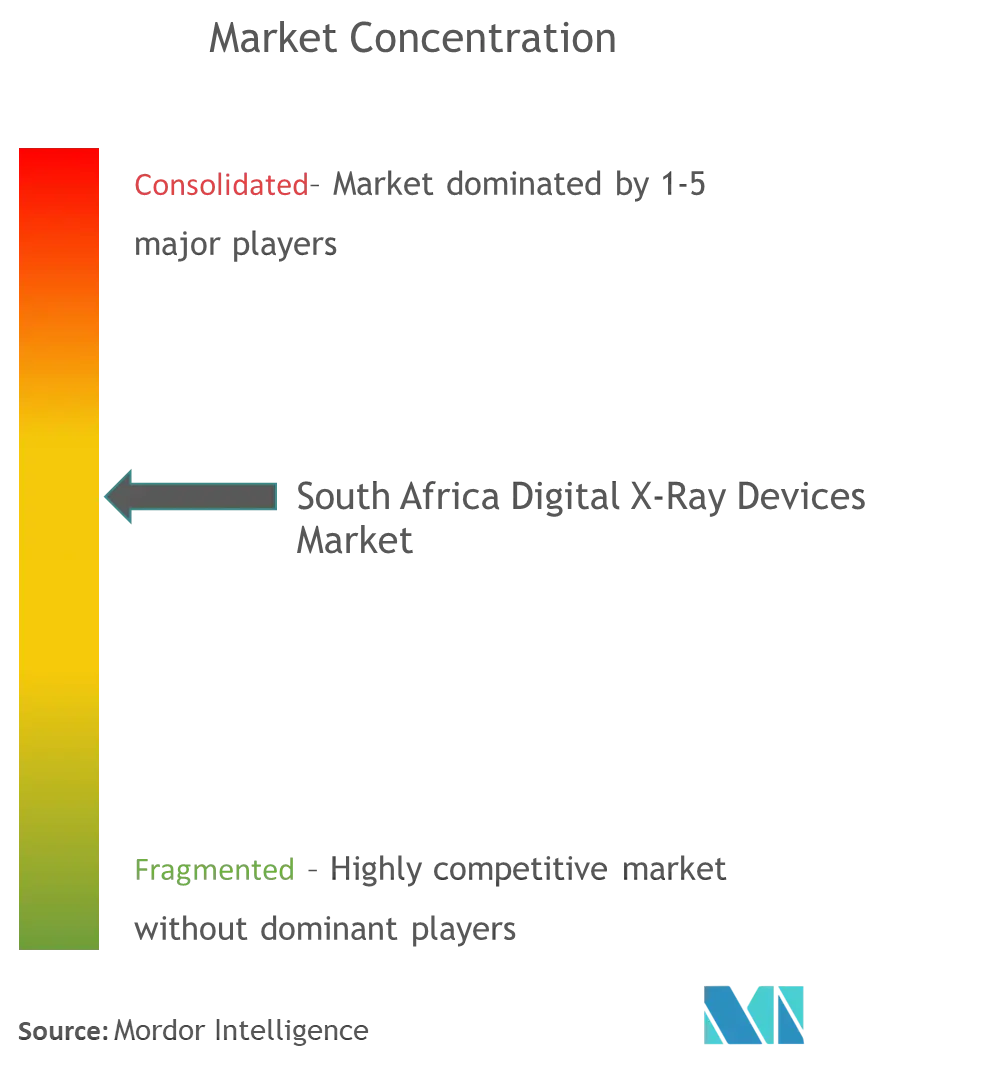South Africa Digital X-Ray Devices Market Size

| Study Period | 2019 - 2029 |
| Base Year For Estimation | 2023 |
| Market Size (2024) | USD 160.51 Million |
| Market Size (2029) | USD 222.63 Million |
| CAGR (2024 - 2029) | 6.76 % |
| Market Concentration | Medium |
Major Players
*Disclaimer: Major Players sorted in no particular order |
South Africa Digital X-Ray Devices Market Analysis
The South Africa Digital X-Ray Devices Market size is estimated at USD 160.51 million in 2024, and is expected to reach USD 222.63 million by 2029, growing at a CAGR of 6.76% during the forecast period (2024-2029).
South Africa's largest challenge, as a result of COVID-19, was that its population's health requirements outpaced available facilities and beds. Second, the vast majority of individuals are unaware of their health status, which delays treatment, and the system's funding reflects inequity. Doctor Saadiq Kariem, Chief of Operations for the Western Cape Department of Health, indicated in a news article published in October 2020 that Tygerberg Hospital had an estimated backlog of 3,500 surgeries. Similarly, during 20 weeks (between March and August), Groote Schuur Hospital had an estimated backlog of 4,142 procedures. In addition, Doctor Gavin Reagon, the Western Cape Department of Health's chief director of emergency and clinical support services, stated that 4,708 patients were on the waiting list for a hip or knee replacement. Hence, it is observed that COVID-19 had a significant impact on the market studied.
In addition, the same article detailed that as part of the COVID-19 response, the Gauteng department canceled elective procedures at the start of the countrywide lockdown on March 27, 2020. At Baragwanath Hospital, 7,541 elective procedures were postponed, which included 2,880 surgeries from the department of ophthalmology, 1,443 orthopedic treatments, and 1,200 pediatric surgery procedures. Such pandemic measures limited the adoption of elective surgeries in South Africa, thereby, impacting the uptake of digital X-ray imaging across various disease diagnoses. The decline in the number of surgical procedures also indicates the decline in diagnostic imaging that took place during the pandemic in South Africa which indicates the impact of COVID-19 on the market studied.
The major factors driving the growth of the market are the increasing prevalence of cancer, increasing technological advancements, and growing applications of digital x-ray imaging in the fields of orthopedic, dental, and cardiovascular disease diagnosis in South Africa. Moreover, the data published in 2021 by the Department of Nuclear Medicine at the University of Pretoria states that the university is collaborating with several international organizations and institutes to promote diagnostic imaging tools. Moreover, digital X-ray devices have several applications in diagnosing many chronic disorders, which then fuel the overall market growth.
Therefore, looking at the all above-mentioned factors, it is believed that the digital X-ray market is expected to witness healthy growth in South Africa over the forecast period.
South Africa Digital X-Ray Devices Market Trends
This section covers the major market trends shaping the South Africa Digital X-Ray Devices Market according to our research experts:
Cancer Holds Significant Share in the Application Segment
The major factors attributing to the growth of this segment in South Africa include the high number of the geriatric population who are at risk of cancer and greater applications of digital x-rays in diagnosing many types of cancer diseases. Many research studies are being conducted in the country that can boost the market growth.
South Africa has one of the highest incidence rates of cancer in the sub-Saharan region. For instance, according to the International Agency for Research on Cancer published Globocan 2020 report, the total number of cancer cases in South Africa in the year 2020 was 108,168. The report also stated that the number of deaths amounted to 56,802. Additionally, according to the same source, the number of cancer cases is expected to increase up to 175k by the year 2040. The high burden of cancer disorders is expected to boost the market growth for digital x-ray devices for diagnosis. Since digital x-ray imaging can be used for the diagnosis of different types of cancer, there is likely to be a demand for this application in the forecast period.
Many research studies are being conducted in South Africa that uses digital x-rays for cancer diagnosis. For instance, in 2021, an article titled, 'Recommendations for lung cancer screening in Southern Africa' was published by Coenraad F. N. Koegelenberget al. and others in the Journal of Thoracic Disease. The researchers recommended a conservative threshold of 6 mm for a positive baseline screen during x-ray screening for lung cancer. They also stated that if a non-calcified solid or partly solid nodule is 6 mm, but 10 mm with no malignant features, the low-dose computed tomography(LDCT) should be repeated in 6 months. Thus, recommendations such as these that ask patients to seek X-ray-based screening for lung cancer are expected to boost the market growth.
Hence, the above developments are further expected to improve the market growth in this segment.

South Africa Digital X-Ray Devices Industry Overview
The South Africa digital X-ray devices market is consolidated and moderately competitive as per the competitive analysis owing to the few companies that are currently dominating the market. These companies include GE Healthcare, Koninklijke Philips NV, Fujifilm Holdings Corporation, Siemens Healthineers, and Canon Medical System Corporation (Toshiba Corporation) among others. The competition in the market is majorly based on technological advances and the pricing of digital X-ray equipment.
South Africa Digital X-Ray Devices Market Leaders
-
GE Healthcare
-
Koninklijke Philips N.V.
-
Canon Medical Systems
-
Fujifilm Holdings Corporation
-
Siemens AG
*Disclaimer: Major Players sorted in no particular order

South Africa Digital X-Ray Devices Market News
- In March 2021, The Philips Foundation, Philips South Africa, and Delft successfully collaborated to deploy CAD4COVID at 11 South African hospitals. With the new strain of COVID-19 spreading across South Africa, the use of CAD4COVID on x-rays in these 11 hospitals enabled the country to increase the detection of COVID-19, quantify progression, and alleviate pressure on hospitals and their healthcare workers.
- In March 2021, Western Cape MEC for Health Nomafrench Mbombo unveiled a mobile x-ray clinic at the Brooklyn Chest Hospital to improve chest x-ray imaging for Tuberculosis.
South Africa Digital X-Ray Devices Market Report - Table of Contents
1. INTRODUCTION
- 1.1 Study Assumptions and Market Definition
- 1.2 Scope of the Study
2. RESEARCH METHODOLOGY
3. EXECUTIVE SUMMARY
4. MARKET DYNAMICS
- 4.1 Market Overview
-
4.2 Market Drivers
- 4.2.1 Increasing Occurrence of Orthopedic and other Chronic Diseases
- 4.2.2 Advantages of Digital X-ray Systems Over Conventional X-rays
-
4.3 Market Restraints
- 4.3.1 High Initial Cost of Installation and High Device Cost
-
4.4 Porter's Five Forces Analysis
- 4.4.1 Threat of New Entrants
- 4.4.2 Bargaining Power of Buyers/Consumers
- 4.4.3 Bargaining Power of Suppliers
- 4.4.4 Threat of Substitute Products
- 4.4.5 Intensity of Competitive Rivalry
5. MARKET SEGMENTATION (Market Size by Value - USD million)
-
5.1 By Application
- 5.1.1 Oncology
- 5.1.2 Cancer
- 5.1.3 Dental
- 5.1.4 Cardiovascular
- 5.1.5 Other Applications
-
5.2 By Technology
- 5.2.1 Computed Radiography
- 5.2.2 Direct Radiography
-
5.3 By Portability
- 5.3.1 Fixed Systems
- 5.3.2 Portable Systems
-
5.4 By End User
- 5.4.1 Hospitals
- 5.4.2 Diagnostic Centers
- 5.4.3 Other End Users
6. COMPETITIVE LANDSCAPE
-
6.1 Company Profiles
- 6.1.1 Canon Medical Systems Corporation
- 6.1.2 Fujifilm Holdings Corporation
- 6.1.3 GE Healthcare
- 6.1.4 Koninklijke Philips NV
- 6.1.5 Siemens Healthineers
- 6.1.6 Carestream Health Inc.
- 6.1.7 Shimadzu Corporation
- 6.1.8 Agfa Healthcare
- 6.1.9 Samsung Medison Co. Ltd
- *List Not Exhaustive
7. MARKET OPPORTUNITIES AND FUTURE TRENDS
** Subject To AvailablitySouth Africa Digital X-Ray Devices Industry Segmentation
As per the scope of this report, digital X-ray or digital radiography is a form of X-ray imaging where digital X-ray sensors are used instead of traditional photographic films. This has an added advantage of time efficiency and the ability to transfer images digitally, as well as enhance them for better visibility. This method bypasses the chemical processing of photographic films. Digital X-ray imaging has high demand, as it requires less radiation exposure compared to traditional X-rays. South Africa Digital X-Ray Devices Market is segmented by Application (Orthopedic, Cancer, Dental, Cardiovascular, and other applications), Technology (Computed Radiography and Direct Radiography), Portability (Fixed Systems, and Portable Systems), End-User (Hospitals, Diagnostic Centers, Other End Users). The report offers the value (in USD million) for the above segments.
| By Application | Oncology |
| Cancer | |
| Dental | |
| Cardiovascular | |
| Other Applications | |
| By Technology | Computed Radiography |
| Direct Radiography | |
| By Portability | Fixed Systems |
| Portable Systems | |
| By End User | Hospitals |
| Diagnostic Centers | |
| Other End Users |
South Africa Digital X-Ray Devices Market Research FAQs
How big is the South Africa Digital X-Ray Devices Market?
The South Africa Digital X-Ray Devices Market size is expected to reach USD 160.51 million in 2024 and grow at a CAGR of 6.76% to reach USD 222.63 million by 2029.
What is the current South Africa Digital X-Ray Devices Market size?
In 2024, the South Africa Digital X-Ray Devices Market size is expected to reach USD 160.51 million.
Who are the key players in South Africa Digital X-Ray Devices Market?
GE Healthcare, Koninklijke Philips N.V., Canon Medical Systems, Fujifilm Holdings Corporation and Siemens AG are the major companies operating in the South Africa Digital X-Ray Devices Market.
What years does this South Africa Digital X-Ray Devices Market cover, and what was the market size in 2023?
In 2023, the South Africa Digital X-Ray Devices Market size was estimated at USD 150.35 million. The report covers the South Africa Digital X-Ray Devices Market historical market size for years: 2019, 2020, 2021, 2022 and 2023. The report also forecasts the South Africa Digital X-Ray Devices Market size for years: 2024, 2025, 2026, 2027, 2028 and 2029.
South Africa Digital X-Ray Devices Industry Report
Statistics for the 2024 South Africa Digital X-Ray Devices market share, size and revenue growth rate, created by Mordor Intelligence™ Industry Reports. South Africa Digital X-Ray Devices analysis includes a market forecast outlook 2029 and historical overview. Get a sample of this industry analysis as a free report PDF download.



